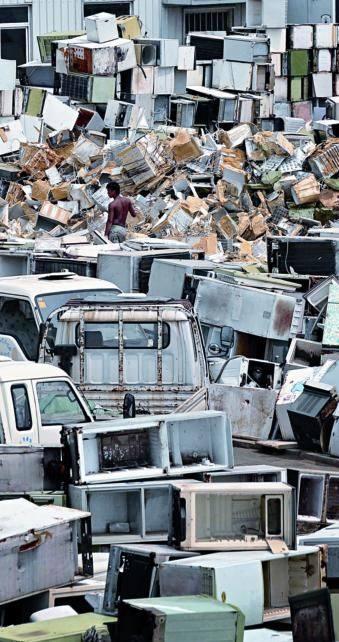The E-Waste Dilemma
YU MING

IN recent years electronic products have become more popular and are frequently updated. Although they undoubtedly provide convenience, throwing out old models to make way for the new creates million of tons of garbage a year.
E-waste, as garbage consisting of electronic products is known, is particularly hazardous to the environment and public health. How to properly dispose of e-waste is now an environmental issue that cannot be ignored.
Scary Figures
E-waste is a problem the whole world faces. According to the report “Recycling– From E-waste to Resources” released by the United Nations Environment Programme, China produces about 2.3 million tons of e-waste every year, second only to the U.S. Experts predict that by 2020 e-waste from old computers will have jumped by 500 percent in India and 400 percent in China and South Africa from the 2007 level. In the coming decade, the number of discarded mobile phones in China will be about seven times higher than the 2007 level and that of discarded televisions and refrigerators will double.
The UN has called for action to deal with this refuse. The situation is particularly acute in many developing countries that lack proper garbage treatment facilities. Many resort to piling up huge mounds of the hazardous material at the closest convenient location. This takes a heavy toll on the environment and endangers nearby residents health.
Studies show that dumped home appliances contain six harmful substances: lead, cadmium, mercury, hexavalent chromium, polyvinyl chloride (PVC) and brominated fl ame-retardants. The soldering tin on printed circuit boards, plastic cases, and cathode-ray tubes of television sets are all toxic. A cathode-ray tube alone contains four to eight pounds of lead.
To make a computer requires more than 700 chemical materials, among which over 300 are hazardous to human health. The average desktop computer monitor contains over 1 kilogram of lead. Long-term exposure to lead can harm a persons kidneys and nervous and circulatory systems. Batteries in laptop computers contain chromium compounds and mercury. The former can penetrate human skin and cells and trigger asthma, while exposure to the latter harms the cranial nerve. Both chromium and mercury can be very harmful to the DNA in human cells and brain functions.
When e-waste is buried or burned, residual heavy metals infiltrate and pollute soil and ground water, directly or indirectly causing harm to nearby residents, plants and animals. Burned organic matter releases large amounts of toxic gases, including the lethally poisonous and cancer-causing agents Dioxin, Furan and Polychlorinated Biphenyl (PCBs).
Recycling Problems
Currently, e-waste is mainly recycled in China by unlicensed private scrap processing businesses, mostly run by families and migrants from the countryside. They salvage parts that can be reused and reasemble them into second-hand home appliances to sell in rural areas. They also make money off salvaged materials like glass and plastics.
Other “useless” components are usually just dumped in the trash, and parts that contain harmful substances will eventually be disposed of by either burial or burning.
But research shows that discarded electronics still have many useful contents, such as metals, plastics, silicon and other components.For example, from one ton of circuit board it is possible to extract 130 kilograms of copper, 0.45 kilograms of gold and 20 kilograms of tin.
Some rural residents in Zhejiang, Fujian and Guangdong provinces have cottoned on to the literally “hidden gold” in e-waste, and have started to make money off salvage operations. At the beginning of the 1990s, a primitive electronic appliance recycling operation emerged in Guiyu Town, in the western part of Shangtou Citys Chaoyang District, Guangdong Province. Today there are still many “ewaste workers” in the town.
Every day thousands of e-waste workers in Guiyu recover and process discarded electronic appliances. They wash circuit boards with sulfuric acid and burn unsalvageable parts. Their work has made the town a world-famous recycling base for discarded electronics. Data show that in 2010 alone, electronic appliances, metals and plastics recycled in Guiyu amounted to 2.2 million tons, bringing the town an economic benefit of RMB 5 billion.
But the news isnt all good. Since March 2005, Greenpeace has collected 44 environmental samples in Guiyu Town and nearby areas. A subsequent report shows that while dismantling e-waste, large volumes of toxic heavy metals and organic compounds are released. The concentration of heavy metals in the air, water and soil has seriously exceeded national environmental standards, the report says. The barium content in soil samples exceeds the standard by over 10 fold, that of tin 152 fold, of lead 212 fold and of chromium 1,338 fold. The concentration of pollutants in local water exceeded the drinking water standards thousands of fold. Medical tests on e-waste processing workers in Guiyu show that a large proportion of them suffered diseases of the skin, the nervous system, the respiratory system and the digestive system.
What is more serious is that there are few legal channels for China-produced ewaste to supply and feed the few modern recycling businesses, forcing them to rely on imported foreign e-waste to continue operation.
Since the beginning of the 1980s, Western countries have been paying more attention to environmental protection. They have made laws and regulations that demand electronic appliance manufacturers recycle their products in order to reduce environmental pollution.
The sad truth is that some manufacturers, in an effort to cut recycling costs, have been exporting their e-waste to developing countries in Africa, Asia, and Latin America.
China introduced its Regulations on the Recycling of Discarded Electronic Products on January 1, 2011, which imposes a fine of RMB 50,000 on importers of e-waste from overseas. But paying this import penalty is no big disincentive when there are such handsome profits to be made in the ewaste business.
Borrowing from Foreign Experience
So how should we deal with e-waste? Some experts suggest China should learn from the successful experiences of foreign countries by setting up discarded e-waste management centers. An aim should be to prove to electronic appliances producers that e-waste recycling can be a profitable side business.
Experts recommend forbidding the action of burying or burning e-waste as a first step. European countries should then be looked to as examples of the best industrial practice. The continent has relatively developed recycling and reuse systems in place for discarded electronic products, and professional e-waste disposal enterprises prosper. Switzerland, for example, has 20 such companies. They adopt physical methods, such as smashing, dismantling and separating, but never use chemical methods, such as burning, in order to reduce environmental pollution.
We should also make clear the obligations of players in the e-waste sector. Japan began enforcing its Home Appliance Recycling Law on April 1, 2001, requiring manufacturers to recycle and reuse their old electronic products, and electronics traders to recover and deliver them back to manufacturers. Consumers also have a role to play in ensuring old electronic goods in their possession are disposed of correctly.
Now the internationally popular solution to the e-waste problem is for manufacturers, traders and consumers to coshoulder the responsibility for recycling e-waste. As the producers of the goods, manufacturers still play the major role. Such methods should ensure efficient recycling of e-waste and a reduction in the cost to the environment to the largest extent possible.
The implementation of such a solution is still in its infancy in China. In the Regulations on the Recycling of Discarded Electronic Products, the government encourages only manufacturers to recycle e-waste, or to entrust the waste to a thirdparty that will recycle it on their behalf. But due to the huge costs associated with recycling, many enterprises balk at following the regulations, rendering them ineffective.
A draft document for the collecting and managing of an e-waste recycling fund has been hashed out as part of the Regulations. It requires manufacturers to pay a fee for each piece of recycled e-waste: RMB 15 for a television, RMB 12 for a refrigerator, RMB 7 for a washing machine, RMB 7 for an air-conditioner and RMB 10 for a laptop. But many manufacturers fi nd it diffi cult to accept such high charges and their objections have halted the implementation of the law.
To encourage manufacturers to recycle e-waste, it would perhaps be wiser for the government to put in place incentive measures, such as tax deductions according to the amount of e-waste an enterprise recycles.
As for corporations e-waste dumping practices, Ma Jun, director of the Institute of Public and Environmental Affairs, points out: “To enhance peoples awareness of environmental protection, it is never enough to rely on an information campaign. Concrete policies and measures have to be made.”
Nigeria is one country that has made successful efforts to stop e-waste dumping. Once local authorities spot a ship transporting e-waste heading into one of the countrys ports, they will stop the ship and send it away.
As for the day-to-day struggle of ensuring e-waste is properly treated, China is wise to look to Vancouver, Canada. Authorities there have put in place strict regulations that stipulate a minimum fi ne of C$50 to be imposed on anyone who throws e-waste away with the daily trash. In addition, the offending party is required to pay 50 percent of the fee for separating and disposing of the e-waste. Chinas ewaste management system is finding its feet, but would fi nd it worthwhile to study the experience of developed countries like Canada.
The Chinese government also needs to take action to ban illegal e-waste dismantling workshops, and at the same time help professional companies with qualifi ed personnel enter the e-waste disposal market. Ensuring the rule of law is enforced in the sector will provide basis for its further development

